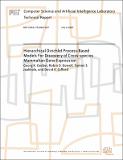Hierarchical Dirichlet Process-Based Models For Discovery of Cross-species Mammalian Gene Expression
Author(s)
Gerber, Georg K.; Dowell, Robin D.; Jaakkola, Tommi S.; Gifford, David K.
DownloadMIT-CSAIL-TR-2007-037.ps (23.20Mb)
Additional downloads
Other Contributors
Computational & Systems Biology
Advisor
Dave Gifford
Metadata
Show full item recordAbstract
An important research problem in computational biology is theidentification of expression programs, sets of co-activatedgenes orchestrating physiological processes, and thecharacterization of the functional breadth of these programs. Theuse of mammalian expression data compendia for discovery of suchprograms presents several challenges, including: 1) cellularinhomogeneity within samples, 2) genetic and environmental variationacross samples, and 3) uncertainty in the numbers of programs andsample populations. We developed GeneProgram, a new unsupervisedcomputational framework that uses expression data to simultaneouslyorganize genes into overlapping programs and tissues into groups toproduce maps of inter-species expression programs, which are sortedby generality scores that exploit the automatically learnedgroupings. Our method addresses each of the above challenges byusing a probabilistic model that: 1) allocates mRNA to differentexpression programs that may be shared across tissues, 2) ishierarchical, treating each tissue as a sample from a population ofrelated tissues, and 3) uses Dirichlet Processes, a non-parametricBayesian method that provides prior distributions over numbers ofsets while penalizing model complexity. Using real gene expressiondata, we show that GeneProgram outperforms several popularexpression analysis methods in recovering biologically interpretablegene sets. From a large compendium of mouse and human expressiondata, GeneProgram discovers 19 tissue groups and 100 expressionprograms active in mammalian tissues. Our method automaticallyconstructs a comprehensive, body-wide map of expression programs andcharacterizes their functional generality. This map can be used forguiding future biological experiments, such as discovery of genesfor new drug targets that exhibit minimal "cross-talk" withunintended organs, or genes that maintain general physiologicalresponses that go awry in disease states. Further, our method isgeneral, and can be applied readily to novel compendia of biologicaldata.
Date issued
2007-07-06Other identifiers
MIT-CSAIL-TR-2007-037
Series/Report no.
Massachusetts Institute of Technology Computer Science and Artificial Intelligence Laboratory